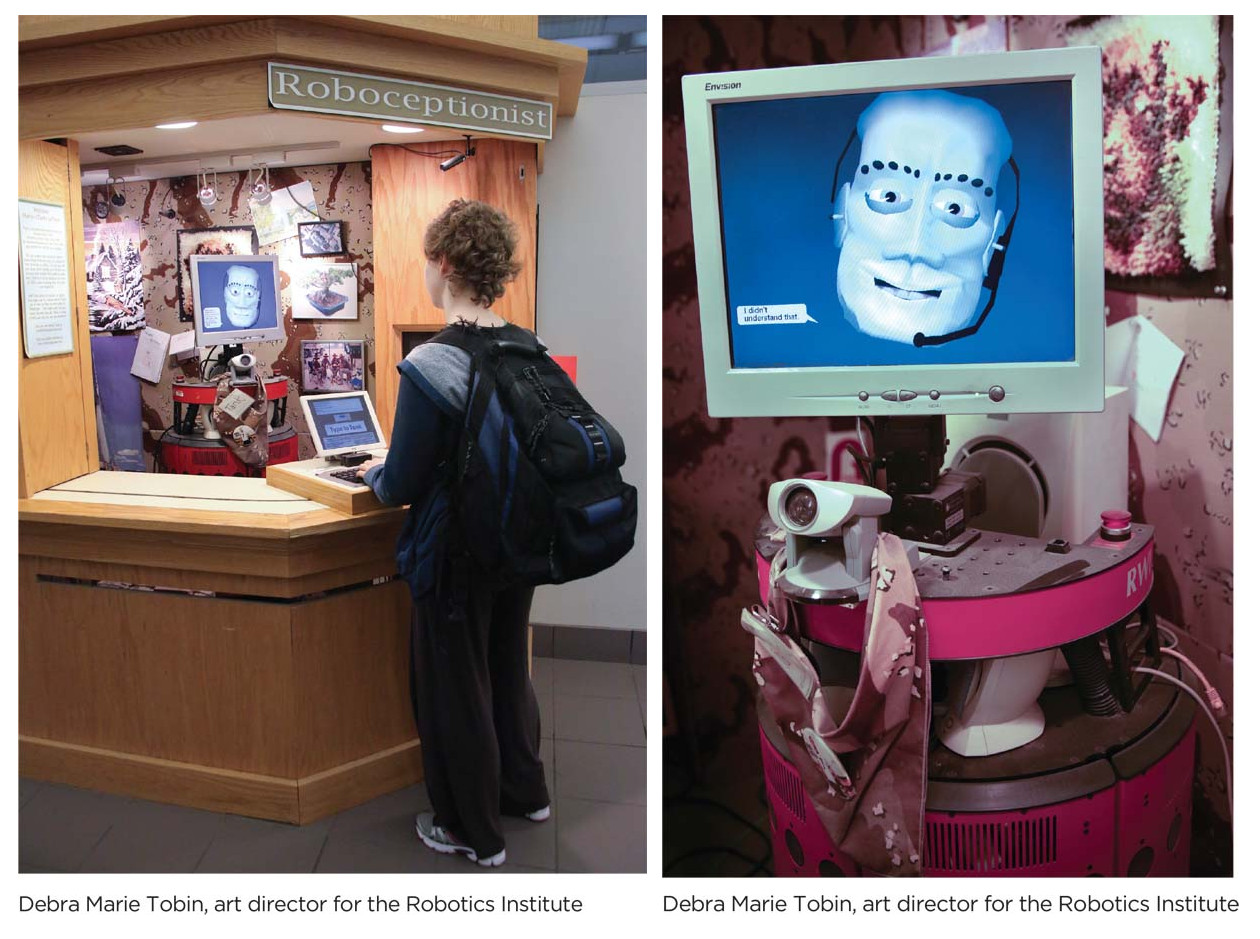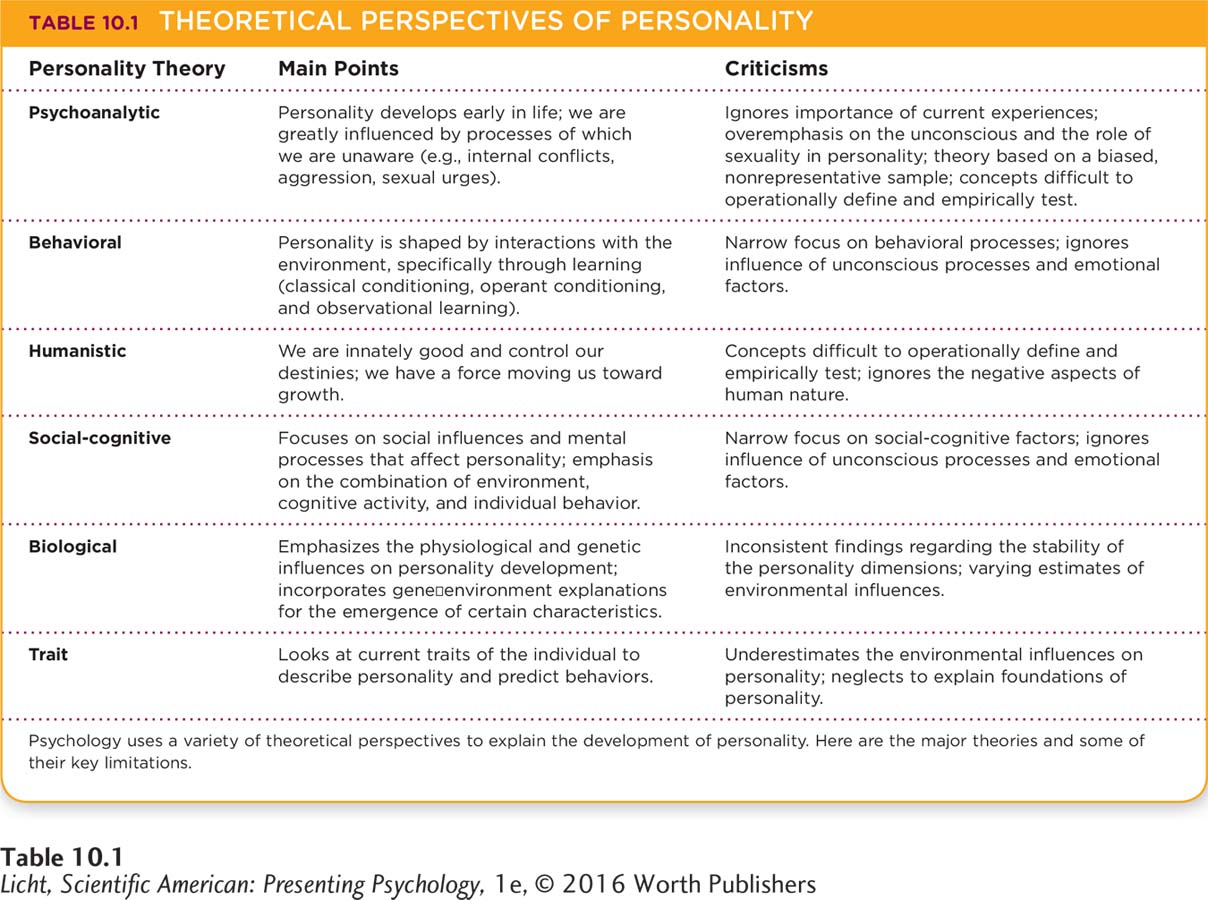10.1 An Introduction to Personality
403
MEET TANK Often, in the lobby of a business or other establishment, a receptionist is the first employee you encounter. The receptionist shapes a visitor’s first impression, and thus should be friendly, eager to help, and reliable. A neat physical appearance and pleasant voice are also big pluses.
Newell Simon Hall, the computer science building at Pittsburgh’s Carnegie Mellon University, has an excellent receptionist. His name is Marion LeFleur, but everyone calls him “Tank,” a fitting title given his square jaw and overall tough-
Perhaps you feel like you’re beginning to know Tank, getting a basic sense of the type of person he is. But wait. Tank isn’t a person; he is a robot—

The Computer Science Department at Carnegie Mellon University has a robot receptionist named “Tank.” Some of Tank’s behaviors are amazingly humanlike; he blinks, flares his nostrils, and even displays emotional expressions consistent with what he is saying (Simmons et al., 2011). But no matter how “human” Tank may seem, he does not possess a true personality.
Note: Quotations attributed to Dr. Reid Simmons are personal communications.
404
LEARNING OBJECTIVES After reading and studying this chapter, you should be able to:
LEARNING OBJECTIVES After reading and studying this chapter, you should be able to:
LO 1 Define personality.
LO 2 Distinguish how the perspectives of psychology explain personality development.
LO 3 Illustrate Freud’s models for describing the mind.
LO 4 Summarize Freud’s use of psychosexual stages to explain personality.
LO 5 Explain how the neo-
LO 6 Summarize Maslow’s hierarchy of needs, and describe self-
LO 7 Discuss Rogers’ view of self-
LO 8 Use learning theories to explain personality development.
LO 9 Summarize Rotter’s view of personality.
LO 10 Discuss how Bandura uses the social-
LO 11 Distinguish trait theories from other personality theories.
LO 12 Identify the biological roots of the five-
LO 13 Explain why reliability and validity are important in personality assessment.
LO 14 Define projective tests and evaluate their strengths and limitations.
LO 15 Describe objective personality tests and evaluate their strengths and limitations.

Looking at Tank, it’s quite obvious he is not a person. His blue, chiseled face lives in a 15-
Tank is a product of Carnegie Mellon’s Social Robots Project, a collaboration between the university’s Robotics Institute and School of Drama. The goal is to “create a robot that can provide useful services, but that also exhibits personality and character” (Gockley et al., 2005, p. 2199). How is this accomplished? Every one of Tank’s behaviors, from the movements of his eyes to the subtle tilts of his head, is preprogrammed by Dr. Simmons’ team of computer whizzes. His backstory and script were written by members of the university’s drama department. It’s all “smoke and mirrors,” according to Dr. Simmons. Creating the illusion of a “personality” turns out to be quite a challenge. This would be no surprise to psychologists studying personality. 
What Is Personality?
One of the major challenges of creating social robots is programming behaviors that gel coherently. If you want to craft a robot with a convincing personality, you’d better make sure that everything it does and says fits the part. One out-
LO 1 Define personality.
personality The unique, core set of characteristics that influence the way one thinks, acts, and feels, and that are relatively consistent and enduring throughout the life span.
So far we have used the term “personality” rather loosely. The reality is that robots do not actually have personalities. They take on roles or personas whose characteristics may bear resemblance to personalities, but all of their behaviors are programmed by people. Well then, what is personality? Generally speaking, personality refers to the unique, core set of characteristics that influence the way one thinks, acts, and feels—
We should point out that personality is not the equivalent of character. When people discuss character, they often are referring to qualities of morality or culture-
405
CONNECTIONS
In Chapter 8, we described various infant temperaments. Some infants are easy to calm, others cranky, sociable, or highly reactive. Humans are born with certain temperaments, and many of the attending characteristics seem to persist throughout life. Here, we introduce temperament in the context of personality.
TEMPERAMENT Some aspects of adult personality appear to derive from temperament, the distinct patterns of emotional reactions and behaviors observed early in life. Because various temperaments are evident in infants, they appear to have a genetic basis (Plomin, DeFries, Knopik, & Neiderhiser, 2013). But even though temperament remains somewhat stable across the life span (Kagan & Snidman, 1991; Sigelman & Rider, 2009), it can be molded by the environment (Caspi, Roberts, & Shiner, 2005). You can think of temperament as one dimension of the broader construct of personality (Goldsmith et al., 1987).
LO 2 Distinguish how the perspectives of psychology explain personality development.
PERSPECTIVES ON PERSONALITY Psychologists explain the development of personality in a variety of ways, often in accordance with certain theoretical perspectives (Table 10.1). None of the perspectives can completely account for the development and expression of personality, but they do help describe, explain, and predict behavior. Most have strong ties to their founders, all of whom were influenced by the historical period in which they lived. Sigmund Freud’s emphasis on sexuality, for example, was partly a reaction to the Victorian cultural climate into which he was born.

406
In the next section, we will examine these theories of personality in greater depth, but first let’s take a quick detour somewhere fun. How would you describe your sense of humor?
Nature and Nurture

Identical twins, who have all the same genes, are more likely to have similar humor styles than fraternal twins, who share only about half their genes (Baughman et al., 2012). This suggests that sense of humor is to some degree inherited.
The Funny Thing About Personality
 Some of us rely on humor to connect with other people, cracking jokes and acting silly for their enjoyment. Others use it as a way to cope with challenges. (We must admit, it does feel good to let loose and laugh when life’s stresses become unbearable.) Both of these styles of humor are viewed as positive, as they strengthen social bonds and promote personal well-
Some of us rely on humor to connect with other people, cracking jokes and acting silly for their enjoyment. Others use it as a way to cope with challenges. (We must admit, it does feel good to let loose and laugh when life’s stresses become unbearable.) Both of these styles of humor are viewed as positive, as they strengthen social bonds and promote personal well-
Where do these styles of humor originate? According to one large Australian study, identical twins (who have identical genes) are more likely to share humor styles than fraternal (nonidentical) twins. What this tells you is that genes matter. In fact, the study suggests that 30–
HUMOR IS VERY MUCH LIKE OTHER ASPECTS OF PERSONALITY—
Over 7 billion human beings inhabit this planet, and not one of them has the same personality as you. Each individual’s personality reflects a distinct interplay of inborn characteristics and life experiences. Consider this nature-
show what you know
Question 1
1. ____________ is the unique core set of characteristics that influence the way one thinks, acts, and feels.
Personality
Question 2
2. Which perspective explains personality based on the effects of reinforcers and other environmental influences?
psychoanalytic
trait
social-
cognitive behavioral
d. behavioral
Question 3
3. How do character and temperament differ from personality?
Personality is a unique core set of characteristics that influences the way one thinks, acts, and feels, which is relatively consistent and enduring throughout the life span. Temperament is a distinct pattern of emotional reactions and behaviors that can be observed early in life, and may be considered one dimension of personality. Unlike personality, which can be assessed with objective measures, character refers to culture-